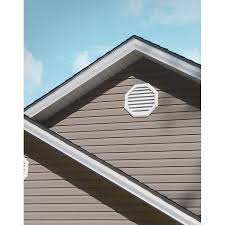Vent size for an Attic
The purpose of attic ventilation is obvious in the summer, when hot air collects in the attic and makes the entire house uncomfortable. But venting has an equally important function in the winter — the air circulation it provides evaporates condensation that forms as warm air rises from the house and meets the cold air in the attic. In order to provide this circulation, attic vents must conform to size requirements established by the International Residential Code (IRC).
How Venting Works
An attic can have a passive venting system or an active one. A passive system consists of inlet vents located at the lowest points of the roof — usually the soffits or drip edge — and exhaust vents located in the gables or roof. The air that enters through the soffits gets heated in the attic space and, because hot air rises, it exits through the roof or gable vents. If there is sufficient venting area, and it’s properly distributed, this air movement creates a draft that keeps air circulating. In an active system, electric, solar or wind-driven fans aid the circulation.
Types of Vents
Inlet vents are usually located in the soffits and open into the attic floor — they may be rectangular or circular grids or screens that run the length of the soffit. Houses with flat roofs may have vents located along the drip edge or under the lowest row of shingles. Exhaust vents can be large louvers set into the gables or on the roof deck near the peak. Ridge vents are also an option for most houses — they can run the length of the ridge line and are often covered by the cap shingles.
Venting Area
The IRC requires that the combined intake and exhaust vent area for a given attic be 1/150 of the attic’s floor area. If at least 40 percent — and no more than 50 percent — of the venting area consists of exhaust vents, however, the requirement is that the venting area be 1/300 of the attic floor area. Some states have their own rules for this exception. For example, in California, at least 50 percent of the venting must be 3 feet or more above the eaves or cornices. Builders usually design attic venting systems to take advantage of this exception.
Sizing and Installing Vents
If your attic area measures 1,000 square feet, you need 3.33 square feet — or 480 square inches — of vent area equally divided between intake and exhaust vents. Knowing this, your next task is to decide which types of vents work best for the design of your house. The venting area of each vent is clearly written on its package, so you simply have to buy enough of them to do the job. It’s important to install them so that the venting area is evenly distributed throughout the attic, which is easier to do when you install continuous soffit or ridge vents.
